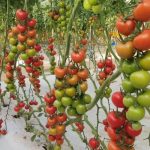The late beginning of the Moroccan season of early vegetables, following a challenging developing summer, has disrupted the regular routine that is typical of Moroccan campaign. Although prices for Moroccan vegetable varieties typically drop in the months of September/October, and then increase in January/February, this year we are experiencing the opposite. The decision of Mauritania to raise the customs duty on fresh Moroccan products has caused confusion. Oussama Machi who is a farmer and vegetable cultivator located in the Souss Massa region, shares his thoughts on the erratic 2023-2024 timeframe.
Machi says: “It is well known that the Souss Massa region accounts for 80percent of the country’s early vegetable production, and 67 percent of exports. This region’s production is crucial for the Moroccan agriculture campaign. This is why the hard summer we had to endure that saw record temperatures, crop diseases, seeds being scarce, as well as the slow start of the campaign are defining elements that influenced the Moroccan campaign in general.”
The tardy start to the campaign may be because of uncertainty about the field, according to Machi. “Growers had been searching for seeds that are that were resistant to ToBRFV. This is now a major problem in Morocco. Everybody had a reason to wait before taking a risk What to grow? using what seeds? for how many acres? for what cost? The decision to plant was made by the last moment. The wait-and-see approach in October and the loss of crop in the summer, contributed to an increase in supply and costs on market for exports and local market.” Unexpectedly, this forecast resulted in an overproduction.
Oussama Machi Moroccan producer and exporter of freshly harvested produce located on Souss Massa
After all growers had committed themselves to plant, the temperatures, that had been aggravating in the beginning of the season, became much more pleasant: “Temperatures oscillated between 27 and 33 degrees. This is unprecedented,” describes Machi. “The historic average for this area is 14 degrees. The exceptional warmth provided the ideal conditions for the production of vegetables. Furthermore was that the sunny, clear skies offered optimal light for the growth of plants, which helped boost the production”.
The delay in the planting of vegetables and harvesting, accompanied by more favorable weather conditions, led to an increase in production of all the early crops and a subsequent decline in the costs. Machi writes: “Prices for Moroccan tomatoes are down by more than 80% on the market in Morocco, and for peppers, by 50 percent. Prices for exports have decreased substantially, with the greatest impact in France. Prices for zucchinis remain steady. Only exceptions to this are beans, which are green as well as flat, and cucumbers which have seen prices rise due to the decline in acres, explained by the low profits in the last couple of seasons.”
The decrease in price was noticed – and celebrated at the market in town which was held the day following Mauritania’s decision to raise customs duties on Moroccan fresh fruits and vegetables. However, for Machi the correlation doesn’t suggest causation. And making the connection between two things is not a valid argument. Machi says: “You have to look beyond the time. In the beginning, this particular season has witnessed extraordinary excess production in Morocco and is directly at the root of the decrease in the prices. Mauritania isn’t importing that much of Moroccan vegetable products, so the decrease in exports from the country is too small by volume that it will have an effect on prices in Morocco and also on exports.”
The grower goes on to say: “Mauritania is first and most importantly an important distribution hub. A majority of goods transit from there into West Africa, and the rise in customs duty does impact the trucks. However, it is true the fact is that West Africa imports a lot of Moroccan fruits and vegetables. However, the end of the wet season in these countries has made the opportunity to domestic production, and the decline in Moroccan exports. This was felt fast, because Moroccan producers had difficulty coordinating to their market in Africa because of the presence in the middleman system of many intermediaries. With our surplus of production there is currently enough amounts for everyone, as long as the demand increases”.
Volumes of vegetable production are increasing in Morocco however the demand for it, especially from Europe is falling behind. This is because of increased temperatures across the Mediterranean basin, according to Machi. “This season’s extraordinary warmth was also observed in the other countries that produce a large amount of food including Spain, Italy, Turkey and Egypt. Every production in these countries is correlated with Europe and we’ve observed the results by way of decreased costs. European demands have therefore dropped significantly, which is also the case for tomatoes shipped to the UK for instance, where production has decreased by 30%..”
What can we expect from the remainder of this exciting season? “One thing is for certain: the prices will increase again prior to the close of the season,” says Machi. “Many farmers are severely short of cash for their agricultural operation, and many are lacking the motivation to do so. The trend is increasing of removals and plantations are left to manage their own. As a result, we’ll see less yields from late-season vegetables.”
“It’s hard to pinpoint the exact date when prices will go up and if this occurs during the Ramadan season, or even before or following. It is confirmed that the campaign to export vegetables is expected to end by May the time when local produce across Europe is likely to be in stock. However, it’s likely that the growth in the amount of intensity as that seen in the months of October and December,” concludes Machi.
More information is available here:
Oussama Machi
Casamance Food
Tel: +212661178150
Email: oussama.machi@gmail.com
